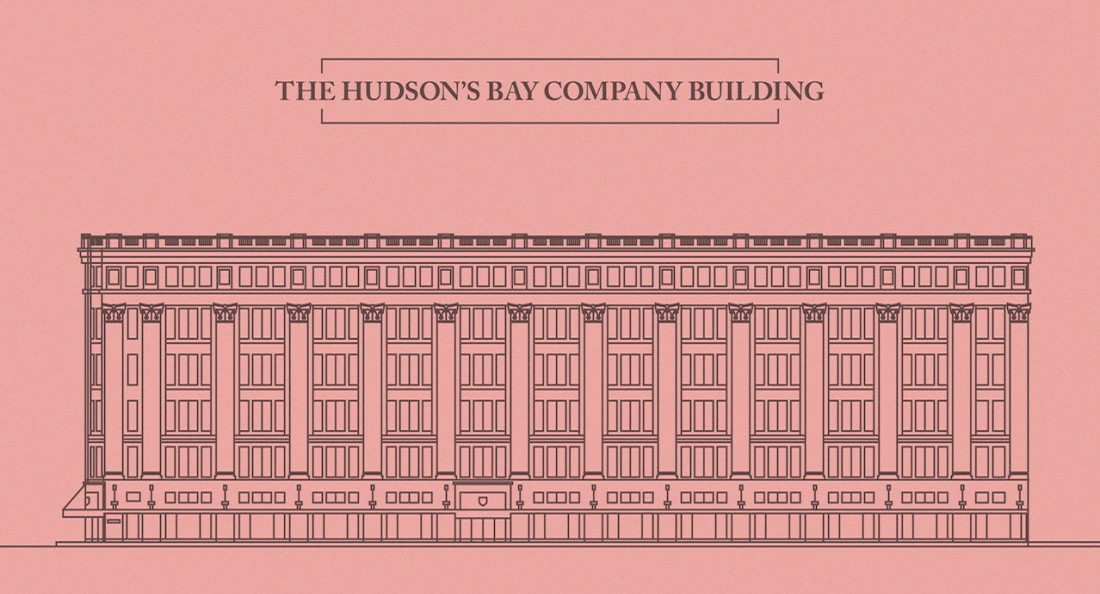Historical futures of the downtown Hudson’s Bay
Envisioning new life into an almost-century-old building
A hallmark of holiday shopping. A gateway to the skywalks. Whatever Winnipeg’s downtown Hudson’s Bay location brings to mind, its near century-long history at the heart of downtown Winnipeg has made a profound mark in the public memory.
Nestled between Portage Avenue and the Manitoba Legislative Building, the former department store, now closed as of Nov. 30, opened its doors in Winnipeg in 1926. Now, a new chapter begins, as the search for ideas to bring new life into the building commences.
“There’s a lot of plans that have been talked around in years past. Now is the time that we need to start acting on those plans and figure out what makes sense for our downtown,” Dayna Spiring, the CEO of Economic Development Winnipeg, says.
As the chair of the mayoral advisory committee struck to determine the future of the downtown Hudson’s Bay building, Spiring says the advisory committee is looking into options that are economically viable and serve the community.
Gordon Goldsborough, the president of the Manitoba Historical Society (MHS), says he would like to see the building repurposed in a way that honours its historical significance.
“If there wasn’t a Hudson’s Bay Company (HBC), there wouldn’t be a Winnipeg,” he says. He explains that European fur traders brought in by HBC founded the Red River Colony, which eventually became to be known as the City of Winnipeg.
HBC was established 350 years ago as a fur trading post. As the demand for retail and the demise of trading took place in the early 1900s, HBC adapted by establishing six department stores across Canada, one of which was the former downtown Winnipeg location.
While the HBC is deeply embedded in Winnipeg’s history, for many, the role the company played was detrimental. The HBC was a major force in settler colonialism and the forced dependence of Indigenous peoples on the fur trade for survival.
In contrast to the substantial vacancies that the downtown HBC store had leading up to its closure in November 2020, the building was originally filled with variety. In the early stages, it housed a hair salon, a post office, a library and, at one point, an auditorium complete with an orchestra.
At a time when department stores thrived, it was a hallmark of holiday shopping, drawing seasonal visitors from every corner of the city.
“It was one of the early department stores,” Goldsborough says. “I have memories, as a child in the 1960s, of going downtown with my mother to the Eaton’s store or the Bay store. It was literally the retail centre of the city at the time.”
As decades passed, the building continued to evolve and adapt to the times. Throughout the years, it has been the home of a basement grocery store, a cafeteria and numerous restaurants, including the Paddlewheel, which was in operation from 1954 to 2013.
The downfall of the downtown HBC store has followed in the pattern of other department stores, such as Sears, which have seen a decrease in demand due to the rise of online retailers. At its closure, only two out of the six floors were in use and open to the public.
Still, the building and what it once housed carry a significant role in the history and memory of Manitoba.
Goldsborough has a unique vision for the building that he coins the Manitoba Memories Centre. As an homage to the deep historical roots that the building represents, Goldsborough envisions the building being transformed into a “repository for memory” that would showcase the history of Manitoba.
With its abundance of floor space, Goldsborough says the building would arguably be most successful as a multi-use facility. He says that while parts of the building could be transformed into offices and smaller-scale retail space, other areas could be used for archival storage.
“The provincial archives are right next door to the Bay building. They don’t have as much space to store their archives as they would need. The result is that a lot of the stuff is not physically located in the archives building,” Goldsborough says.
He says that the Archives of Manitoba building is also home to the Hudson’s Bay Company archives, which have received designation by the United Nations Educational, Scientific and Cultural Organization (UNESCO).
“There’s all kinds of heritage organizations in the province. Why not have them all under one roof?” he says. “That to me would be a great way to then emphasize that this building, this old Bay store, is a centre for the retention of memory in Manitoba.”
Some proposals for the future of the building have called to acknowledge the colonial roots of the Hudson’s Bay Company, and repurpose the former downtown Bay store into a space that both acknowledges the past and serves Indigenous communities and organizations.
In a column for the Winnipeg Free Press, Dr. Niigaan Sinclair imagines the future of the former Bay building as a place for Indigenous community-building and excellence.
“Let’s make Winnipeg’s most non-Indigenous space Indigenous space. Let’s make it a place where our community can renew, change and enter the next 350 years of our lives together,” Sinclair writes in the article.
Whatever plan is implemented, Spiring says the advisory committee will have to decide on something that is economically feasible.
“Ultimately, commerce is going to prevail, and we need something that makes financial sense, as well as a good thing for our community,” Spiring says. “Winnipeg has a great opportunity here, and I think this building and what we can reimagine it to be is a pretty exciting thing.”
While the future of the former Bay building is uncertain, it remains a landmark in Winnipeg’s history and a place of nostalgia for many who have walked through its doors.
To learn more about the proposed MHS Manitoba Memories Centre, visit mhs.mb.ca/manitobamemories.
Published in Volume 75, Number 13 of The Uniter (January 7, 2021)







